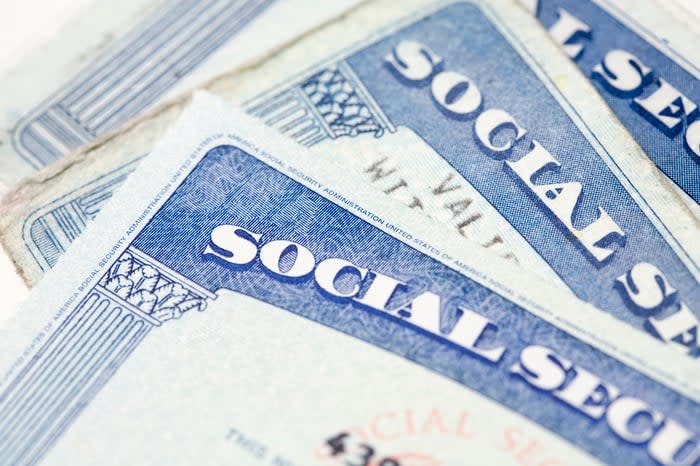Retirees Could Lose 17% of Their Social Security Benefits in 11 Years. Here's Why
Social Security is a lifeline for millions of older adults, often making the difference between a comfortable retirement and struggling to make ends meet.
In fact, a whopping 88% of baby boomers expect to rely on Social Security in retirement, according to a 2023 report from the Transamerica Center for Retirement Studies, with over 40% of boomers saying their benefits will be their primary source of income.
The program is on shaky ground right now, however, and there's a chance that Social Security may not be as reliable in the coming decades. According to the most recent research, your benefits could be slashed by around 17% in just 11 years. Here's what you need to know.

Image source: Getty Images.
Social Security is facing a cash shortage
Social Security has been struggling for years, primarily because its costs outweigh its income. The program relies heavily on taxes to fund benefits, with workers and employers contributing to the system through payroll taxes. That money is then paid out to current beneficiaries.
However, Social Security's income isn't enough to fully cover the amount that needs to be paid out in benefits. Thus, the program is running at a deficit.
As a short-term solution, the Social Security Administration (SSA) has started dipping into its trust funds -- the Old-Age and Survivors Insurance (OASI) fund and the Disability Insurance (DI) fund. This has helped the SSA avoid cutting benefits so far despite the program experiencing a cash shortage.
Benefit cuts could be looming
While the trust funds have helped bridge the gap between what the program receives in income and the amount it needs to pay out in benefits, they're not designed to be a long-term income source. Sooner or later, they'll run out -- and that's when benefit cuts may become a reality.
According to the SSA Board of Trustees' latest estimates, released in May 2024, the OASI fund -- which covers retirement and survivors' benefits -- is expected to be depleted by 2033. At that point, the program's income sources will only be enough to cover 79% of scheduled benefits.
However, it's likely that if the situation becomes that dire, the SSA may tap into the DI fund, too, to pay out retirement benefits. In that case, both trust funds are predicted to run out by 2035, with income sources only enough to cover 83% of future benefits. In other words, benefits could be cut by around 17% when both funds are depleted in roughly 11 years.
Despite some pervasive myths that Social Security is going bankrupt, the program is not going away entirely. Even if the trust funds run out of money, the SSA will still have its income sources, like payroll taxes, to cover the majority of scheduled benefits.
Potential solutions on the table
All of this assumes that Congress won't step in to solve the problem before the trust funds run out, which is unlikely. While lawmakers haven't managed to agree on a solution yet, there are various proposals to help improve Social Security's financial stability.
Raise the full retirement age: By raising the full retirement age from 67 to 68 or above, older adults would need to wait longer to collect 100% of their benefit amount. This would reduce the amount beneficiaries collect over a lifetime, lowering Social Security's expenses.
Reduce benefits for high earners: Reducing benefits for high-earning individuals would have a similar effect, decreasing the amount Social Security has to pay out and helping its income go further. Because this is still only a proposal, it's unclear what the income limits might be or how much benefits could be reduced.
Begin taxing higher incomes: One of the most popular solutions involves taxing income above $400,000 per year for Social Security purposes. As of 2024, only income up to $168,600 per year is subject to Social Security taxes, which limits how much the SSA can pay out in benefits.
Taxing higher income levels is one of the most effective solutions, yet it would eliminate only around 61% of the program's cash shortage, according to a report from the University of Maryland. It's likely, then, that the SSA may need to implement multiple changes to solve the problem.
While all this uncertainty can be unnerving, one of the best things you can do right now is simply stay up-to-date with Social Security's situation. When you have a better idea of what may happen going forward, you can take steps to start preparing your retirement accordingly.
The $22,924 Social Security bonus most retirees completely overlook
If you're like most Americans, you're a few years (or more) behind on your retirement savings. But a handful of little-known "Social Security secrets" could help ensure a boost in your retirement income. For example: one easy trick could pay you as much as $22,924 more... each year! Once you learn how to maximize your Social Security benefits, we think you could retire confidently with the peace of mind we're all after. Simply click here to discover how to learn more about these strategies.
View the "Social Security secrets" ›
The Motley Fool has a disclosure policy.
